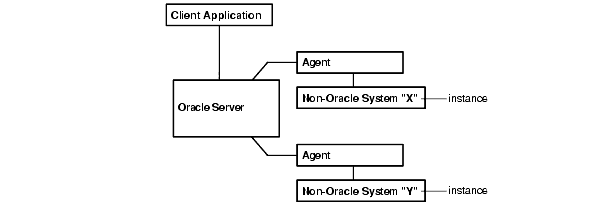Classes and Instances
Using Heterogeneous Services, you can access several non-Oracle systems from a single Oracle database. This is illustrated in Figure 2-2, which shows two non-Oracle systems being accessed.
Figure 2-2 Accessing Multiple Non-Oracle Instances
Both agents upload configuration information, which is stored as part of the Heterogeneous Services data dictionary information on Oracle Database.
Although it is possible to store data dictionary information at one level of granularity by having completely separate definitions in the Heterogeneous Services data dictionary for each individual instance, this can lead to an unnecessarily large amount of redundant data dictionary information. To avoid this, Oracle organizes the Heterogeneous Services data dictionary by two levels of granularity, called class and instance.
A class pertains to a specific type of non-Oracle system. For example, you may want to access the class of Sybase database systems with Oracle Database. An instance defines specializations within a class. For example, you may want to access several separate instances within a Sybase database system. Each class definition (one level of granularity) is shared by all the particular instances (a second level of granularity) under that class. Further, instance information takes precedence over class information, and class information takes precedence over server-supplied defaults.
For example, suppose that Oracle Database accesses three instances of Sybase and two instances of Ingres II. Sybase and Ingres II each have their own code, requiring separate class definitions for Oracle Database to access them. The Heterogeneous Services data dictionary therefore would contain two class definitions, one for Sybase and one for Ingres II, with five instance definitions, one for each instance being accessed by Oracle Database.
Note that instance-level capability and data dictionary information are session-specific and are not stored in the Heterogeneous Services data dictionary of Oracle Database. However, instance-level initialization parameters can be stored in the database.
